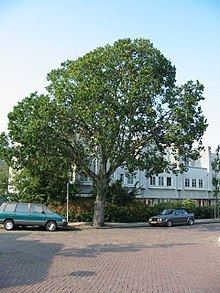Cultivar 'Exoniensis' | ||
 | ||
Similar Ulmus 'Plantyn', Ulmus 'Purpurea', Ulmus minor 'Argenteo‑Variegata', Ulmus 'Dodoens', Ulmus 'San Zanobi' | ||
Ulmus 'Exoniensis', the 'Exeter Elm', was discovered near Exeter, England, in 1826, and propagated by the Ford & Please nursery in that city. Traditionally believed to be a cultivar of the Wych Elm U. glabra, its fastigiate shape when young, upward-curving tracery, small samarae and leaves, late leaf-flush and late leaf-fall, taken with its south-west England provenance, suggest a link with the Cornish Elm, which shares these characteristics.
Contents
Description
The tree initially has an upright, columnar form, but later develops a large rounded crown and occasionally reaches 17 m in height. Older specimens may develop pendulous branches. Exeter Elm is chiefly distinguished by its contorted leaves, < 11 cm long by 8 cm broad, which occasionally wrap around the branchlets and remain thus well into winter. 'Exoniensis' is often pollarded to produce a denser, fan-shaped crown (see main picture).
Pests and diseases
'Exoniensis' possesses a moderate resistance to Dutch elm disease, and consequently often featured in the Dutch elm breeding programme in association with the Field Elm U. minor and Himalayan Elm U. wallichiana.
Cultivation
Once commonly planted in the UK and parts of western Europe, 'Exoniensis' is also known to have been marketed in Poland in the 19th century by the Ulrich nursery, Warsaw, and remains in commerce there. The Späth nursery of Berlin cultivated the tree as U. montana fastigiata (U. exoniensis Hort.) from the early 20th century. It is possible that three trees supplied by the Späth nursery to the Royal Botanic Garden Edinburgh in 1902 as U. montana fastigiata were Exeter Elm, old specimens of which survive in Edinburgh (it was the practice of the Garden to distribute trees about the city). In Sweden 'Exoniensis' is sometimes pruned from an early age to form a tidy cone-shaped tree called locally 'pyramidalm' (: pyramid elm - also one of Späth's names for 'Exoniensis'). It is found in Australia at the Ballarat Botanical Gardens where it is listed on the Significant Tree Register of the National Trust, but is not known to have been introduced to North America.
Notable trees
A 180-year-old specimen in Hamburg has attained a height of 28 m and a trunk diameter of 1.45 m. The UK TROBI Champion tree is in Scotland, at Baxter Gardens, Dundee, measuring 15 m high by 103 cm d.b.h. in 2004. The cultivar is represented in Éire by a tree at Birr Castle (Mount Palmer), County Offaly, with a d.b.h. of 29 cm when measured in 2002.
Hybrid cultivars
'Clusius', 'Columella', 'Dodoens', 'Lobel', 'Plantyn', 'Nanguen' = Lutèce™, 'Wanoux' = Vada™. The cultivar 'Columella' features the same rough, rounded, contorted leaves, the result of a recessive gene inherited from the Exeter Elm.
'Exoniensis' also indirectly featured in the Italian elm breeding programme as an ancestor of 'Plantyn', which was crossed with clones of the Siberian Elm Ulmus pumila to produce the cultivars 'Arno', 'Plinio', and 'San Zanobi'.
